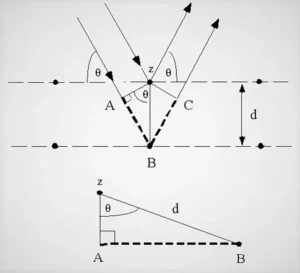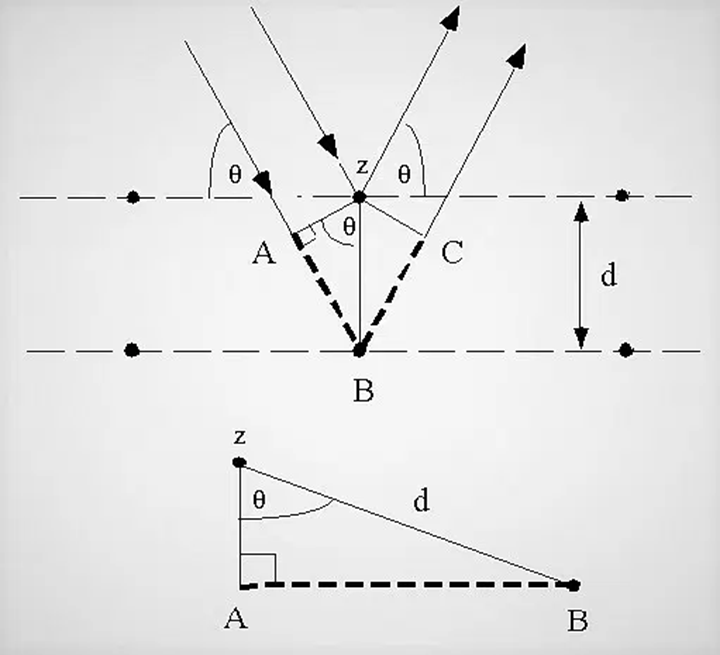W.H. Bragg along with his son William Lawrence Bragg proposed a simple but powerful equation that became known as Bragg’s law showing the connection between the wavelength of the X-rays, the distance between the planes in crystals, and the angle at which the X-rays are reflected. An X-ray is a penetrating energetic electromagnetic radiation that has a wavelength ranging between 10 nm and 10 picometers. This law helps us in understanding the coherent and incoherent scattering from a crystal lattice.
Bragg’s Law and Bragg’s equation
Bragg’s Law states that when the X-ray is incident onto a crystal surface, the angle of incidence, θ, will reflect with the same angle of scattering. And, constructive interference will occur when the path difference, d is equal to a whole number, n, of wavelength, λ.
Bragg’s Law is a special case of Laue diffraction hat helps us in understanding the angles of coherent and incoherent scattering from a crystal lattice. When the X-rays are incident on an atom, it shows the same action in moving the electronic cloud just like an electromagnetic wave does. Braggs law explains the relation between a shooting x-ray light beam and its reflection off a crystal surface.
Bragg’s Equation:
The Braggs equation can be represented as nλ = 2d sinθ
n= an integer
λ = wavelength of the x-ray,
d= spacing of the crystal layers (path difference), and
θ= incident angle (the angle between the incident ray and the scattering plane).
Derivation of 
To derive Bragg’s equation, consider the following figure to observe the phases of beams that coincide when the incident angle is equivalent to the angle of reflection.

The incident beams are parallel to each other before they reach a point, p and when they eventually get to point p, they travel upwards after striking the surface. Then, the second beam scatters when it reaches point B. Now, AB + BC can be considered as the distance that is travelled by the second beam. The extra distance travelled by it is referred to as the integral multiple of the wavelength.
Derivation of Bragg’s equation:
nλ = AB + BC
Now, AB = BC
Thus, nλ = 2AB
Let this be the first equation
Now, considering d as the hypotenuse of the right-angled triangle, ABC, it is clear that AB is the opposite of the angle θ.
Therefore, AB = d sinθ
Let this be the second equation
Substituting the second equation in the first one, we get, nλ = 2d sinθ
Bragg’s Diffraction and X-Ray diffraction
Bragg’s Diffraction: In 1913, Bragg’s diffraction was first proposed by W.H. Bragg and William Lawrence Bragg. Bragg’s diffraction occurs when electromagnetic radiation waves or subatomic particles have wavelengths that are comparable to atomic spacing in a crystal lattice.
X-Ray diffraction: When incident photons are reflected by atoms on separate parallel planes, the reflected rays interfere constructively to form a diffraction pattern, and the lattice characteristics, size, shape, crystal orientation, interplanar distance, and so on can be figured out by analyzing the diffraction patterns.
Applications of Braggs law
Echoes from sound waves are used in Ultrasound to locate different organs inside the body and can be used to monitor the growth of unborn babies.
In the case of WDS i.e., Wavelength Dispersive Spectrometry or XRF i.e., X-ray fluorescence spectroscopy, crystals of known d-spacings are used for analyzing crystals in the spectrometer.
The d-spacing or inter-planar spacing of a crystal is used for identification and characterization purposes in XDR i.e., X-ray diffraction.
A Bragg’s spectrometer is used to determine X-rays’ wavelength, and its construction is similar to that of an optical spectrometer.
Recommended Articles:
Blind Visually Impaired Optical Low Vision Aids
Bohr Model of Hydrogen Atom
Bohr Radius: Introduction, Model ,and FAQ
Boltzmann Constant: Introduction, Formula, Value, Ideal and Applications
Boltzmann Equation : Introduction, Law, Applications, and Example
W.H. Bragg along with his son William Lawrence Bragg proposed a simple but powerful equation that became known as Bragg's law showing the connection between the wavelength of the X-rays, the distance between the planes in crystals, and the angle at which the X-rays are reflected. The wavelengths of first-order X-rays are 3.20. a = 3.20 The distance between adjacent planes in a simple cubic crystal is: d= 3.20 × 1.41 d = 4.512 Answer: In the case of WDS i.e., Wavelength Dispersive Spectrometry or XRF i.e., X-ray fluorescence spectroscopy, crystals of known d-spacings are used for analysing crystals in the spectrometer. The d-spacing or inter-planar spacing of a crystal is used for identification and characterisation purposes in XDR i.e., X-ray diffraction. A Bragg’s spectrometer is used to determine X-rays’ wavelength, and its construction is similar to that of an optical spectrometer. An X-ray is a penetrating energetic electromagnetic radiation that has a wavelength ranging between 10 nm and 10 picometers. The discovery of X-rays was discovered by W.C. Rontgen in December 1895. Braggs Law FAQs
Who gave Bragg’s Law?
If the wavelengths of first-order X-rays are 3.20 Å at 27°8’ then find the distance between the adjacent Miller planes.
Mention the applications of Bragg’s Law.
Define X-ray.